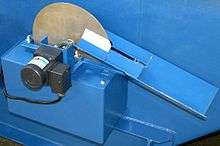Skimmer (machine)
An oil skimmer is a device that separates oil or particles floating on a liquid surface. A common application is removing oil floating on water. Oil skimmers are not oil-water separator devices. They are used for oil spill remediation, as a part of oily water treatment systems, removing oil from machine tool coolant and removing oil from aqueous parts washers. Oil skimmers were used to great effect to assist in the remediation of the Exxon Valdez spill in 1989. Oil skimmers are different to Swimming pool sanitation skimmers that are designed for a related but different purpose.
Limitation and design factors
There are many different types of oil skimmer and each type has different features. It is important to understand the features before employing a particular skimmer type.
Some factors to consider are:
- Oil removal flow rate: Different Skimmer types and designs have different oil removal flow rates. Removal rates for Oleophilic and Non-Oleophilic skimmer types are comparatively low whereas Weir type skimmers are capable of very high oil removal rates.
- Oil removal concentration: A limitation with most skimmer types is that they do not always remove pure "oil" but a mixture of oil and entrained water. In many situations because of weathering and mixing the 'oil' removed is an emulsion of oil and water more like a 'mousse'. Oleophilic and Non-Oleophilic skimmers can provide a more concentrated oil in the removal stream.
- Effectiveness with different oils: Oleophilic and Non-Oleophilic skimmers are not equally effective with all oil types due to the changing nature of the attraction forces with different oils and materials. Weir skimmers are not affected by changing oil types.
- Effectiveness with chemicals in the water: Oleophilic skimmers may not work as effectively if there are detergents, cleaners or other surfactants in the water that interfere with the oleophilic attraction. Weir skimmers are not affected by chemicals.
- Effects of trash and debris: Trash and debris may block or interfere with the operation of oil skimmers.
- Skimming direction: Some skimmers only remove oil from one direction. In some situations, such as skimming from pits and tanks, it can be important to remove oil from all directions.
- Service Access: Some skimmers such as disc skimmers, or weir skimmers with skimmer mounted pumps, contain heavy serviceable items of equipment mounted on the skimmer. This may require special lifting equipment and confined space entry safety considerations before servicing.
Applications
The use of skimmers in industrial applications is often required to remove oils, grease and fats prior to further treatment for environmental discharge compliance. By removing the top layer of oils, water stagnation, smell and unsightly surface scum can be reduced. Placed before an oily water treatment system an oil skimmer may give greater overall oil separation efficiency for improved discharge wastewater quality. It should be noted that all oil skimmers will pick up a percentage of water with the oil which will need to be decanted to obtain concentrated oil.
Types
There are three main types of oil skimmer: weir (manual or self-adjusting) and oleophilic and non-oleophilic (disc, drum, belt, tube, brush,mop, grooved disc, grooved drum):
Weir
Weir skimmers function by allowing the oil floating on the surface of the water to flow over a weir. There are two main types of weir skimmer, those that require the weir height to be manually adjusted and those where the weir height is automatic or self-adjusting.[1] Whilst manually adjusted weir skimmer types can have a lower initial cost, the requirement for regular manual adjustment makes self-adjusting weir types more popular in most applications. Weir skimmers will collect water if operating when oil is no longer present. To overcome this limitation most weir type skimmers contain an automatic water drain on the oil collection tank.

.
Oleophilic
Oleophilic skimmers function by using an element such as a drum, disc, rope or mop to which the oil adheres. The oil is wiped from the oleophilic surface and collected in a tank. Designs attempt to limit the amount of water co-collected even when oil is not present. Oil collection tanks can include water drains to reduce the amount of water collected.
Non-oleophilic

Non-oleophilic skimmers are distinguished by the component used to collect the oil. A metal disc, belt or drum is used in applications where an oleophilic material is inappropriate, such as in a hot alkaline aqueous parts washer.[2] The skimmer is generally turned off whenever there is no oil to skim thus minimizing the amount of water collected. Metal skimming elements are nearly as efficient as oleophilic skimmers when oil is present.
Wendy Schmidt Challenge
Some oil skimming designs entered the Wendy Schmidt Oil Cleanup X CHALLENGE in 2011. The winning technology utilized Grooves placed on the surface of rotating discs.[3]